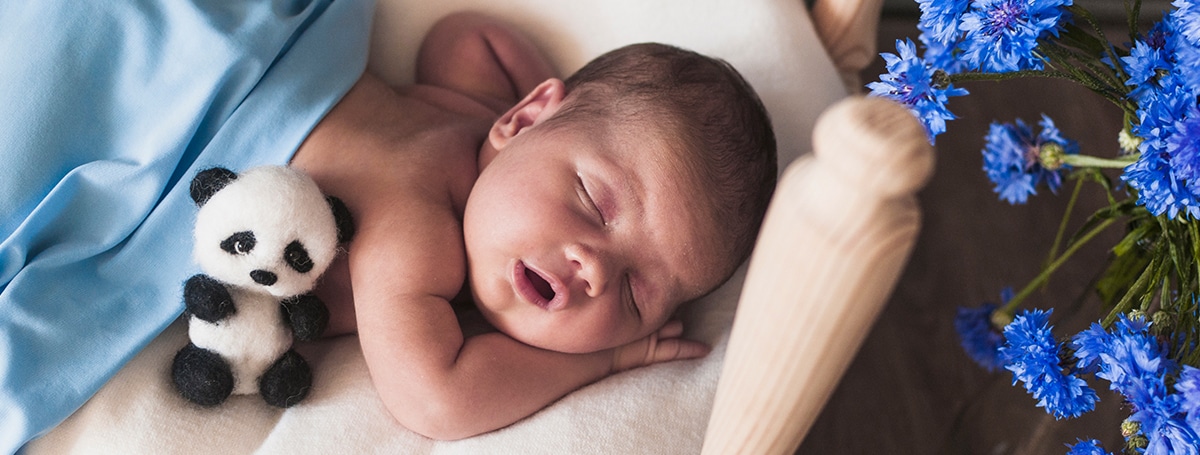1 Month Baby Milestones: Big Changes to Expect in the First 30 Days
Bringing home a newborn is an experience like no other—equal parts magical, overwhelming, and filled with moments you’ll cherish forever. In these first 30 days, your tiny bundle of joy is adjusting to the world outside the womb, while you’re adjusting to a brand-new routine (or, let’s be honest, the lack of one!). You might find yourself wondering: Is my baby growing as expected? Are these little movements normal? Should they be making eye contact yet? Don’t worry—you’re not alone. Monitoring your baby’s growth and development during the first month is important, as it helps ensure your baby’s needs are being met and any concerns are addressed early.
Every new parent has these questions, and the truth is, every baby develops at their own pace. Most children reach certain milestones at similar ages, but there is a range of normal development, and some babies may achieve their milestones a little earlier or later than others. However, there are some key milestones that most newborns experience in their first month, from recognising your voice to those first adorable stretches and reflexive smiles. Remember, it’s natural to not always feel confident as a parent—milestones are simply guidelines for when most children reach certain skills by a certain age, and individual development can vary. Every baby’s development is unique, and tracking your baby’s development can help you and your baby’s pediatrician identify any concerns early on.
So, let’s take a look at what you can expect when it comes to your baby’s 1 month milestones, helping you celebrate your baby’s individual achievements, support your baby’s development, and ease any new-parent jitters along the way.
Our Products
1 Month Baby Milestones: Physical Development
At 1 month old, your little one may be tiny, but they are already working hard to grow stronger every day. Tracking your baby’s growth, including weight gain and how they regain their birth weight, is an important indicator of healthy development. These changes are considered important developmental milestones that show how babies grow and develop during the first month. At this stage, most of their movements are still guided by reflexes rather than conscious effort, but that doesn’t mean they aren’t making progress. Here are key 1-month-old milestones when it comes to your baby’s physical development and overall development.
Reflexes
Newborns come into the world with a set of built-in reflexes designed to help them survive and adapt. Have you noticed your baby instinctively swallowing, sucking, or turning toward you when it’s time to eat? That’s their rooting reflex at work. If you gently place a finger in their palm, they will instinctively wrap their tiny fingers around it—one of the sweetest grips you’ll ever feel. Another fascinating reflex is the stepping reflex. If you hold your baby upright with their feet touching a flat surface, they may move their legs as if trying to walk. Of course, they aren’t quite ready to take off running yet, but it’s an early sign of the coordination they’ll develop in the months to come. And if your baby suddenly flings their arms and legs out when startled, that’s their Moro reflex—a natural response to feeling unsupported or surprised.
Head Control
One of the biggest 1 month milestones is head control. If you place your baby on their tummy for some tummy time, you might see them attempt to lift their head, even if just for a brief moment. It may look wobbly and unsteady, but every little effort is helping them build the strength they need. Even when lying in a car seat or carrier, they’ll start to turn their head from side to side. Their neck muscles are still developing, so you’ll need to continue supporting their head when holding them—but don’t worry, they’ll get there soon.
Movements
Right now, your baby’s arms and legs may seem to move in quick, sudden bursts. They may flail their arms or kick their legs without much coordination—this is completely normal. You might notice that their hands often stay in tight little fists, but every now and then, they’ll start bringing them toward their mouth or eyes. By the time they reach four weeks, you’ll likely see more intentional movements. Maybe they’ll more deliberately bring their hands to their mouth, or maybe their once-random kicks will start to have more rhythm. You may also notice your baby beginning to follow a moving object with their eyes, which is an important part of developing coordination. These little changes may seem small, but they are signs of your baby’s growing control over their body.
1 Month Baby Milestones: Sensory and Cognitive Development
Your little one may not be saying much (other than those adorable coos and cries), but they’re already soaking in the world around them in incredible ways. Paying attention to your baby’s sounds—like cries when hungry or gurgling noises when content—helps you understand how they communicate their needs and feelings. From recognising your voice and scent to reacting to new sights and sounds, their tiny brain is working overtime to make sense of everything. Spending time with your baby with activities like eye contact, talking, and cuddling is important for fostering development and strengthening your bond. When you respond to your baby’s sounds and needs, you support their emotional development and help them feel secure. Here are key 1 month old milestones when it comes to your baby’s mental and sensory development.
Facial Expressions
Ever caught your baby making the cutest little faces? Those raised eyebrows, puckered lips, and wide-eyed stares aren’t just random movements—they’re your baby’s way of experimenting with facial expressions. Babies are naturally drawn to the human face, and recognizing faces is an important part of early social development. While they’re not quite ready to flash a real smile yet, smiling is an important milestone that often appears around 6 weeks and marks a key moment in your baby’s social and emotional development. These little expressions are an early sign of emotional development.!
Sense of Smell
Your baby might not know their name yet, but they definitely know who you are—just by smell. From birth, babies can recognise their parents’ scent, and if you’re breastfeeding, they can even distinguish the unique smell of your milk. That’s why your presence alone can be so soothing. So, the next time they snuggle into your chest and calm down instantly? That’s the magic of scent recognition at work.
Sense of Hearing
By one month, your baby’s hearing is fully developed, which means they’re tuning into the world around them—especially familiar voices. They recognise yours and may even stop crying or turn their head toward you when you talk. On the flip side, sudden loud noises might make them startle or cry. Most babies are startled by a loud noise, and this reaction is a normal part of sensory development.
Sense of Vision
At this stage, your baby’s eyesight is still a work in progress, but they’re beginning to focus on objects about 8 to 12 inches away—perfect for gazing up at you while being held. They’re especially drawn to high-contrast patterns like black-and-white designs, which stand out best to their developing eyes. You might also notice their eyes occasionally crossing or wandering—don’t worry, that’s normal as they learn to control their eye muscles.
Sense of Touch
Your baby is already forming preferences when it comes to touch. They love soft, gentle sensations (think cosy swaddles and warm cuddles) and might fuss if handled too roughly. Holding them close, stroking their tiny hands, and giving gentle massages can all help them feel safe and comforted.
Our Products
1 Month Baby Weight and Height
In just a few short weeks, your baby has been busy growing- and it shows. Tracking your baby’s birth weight and monitoring your baby’s growth over time is important, as it helps ensure they are following a healthy growth pattern. By the time they reach one month, most babies have gained around 900 grams since birth. That may not sound like much, but considering it makes up a significant portion of their original weight, it’s a big milestone. So, how much is the average 1 month baby weight and height? While every baby grows at their own pace, here are the typical weight and length ranges:
- Average 1 month baby weight for boys: Approximately 4.50 kg
- Average 1 month baby length for boys: Approximately 21.5 inches
- Average 1 month baby weight for girls: Approximately 4.20 kg
- Average 1 month baby length for girls: Approximately 21 inches
Most babies reach these average weights and heights by the end of their first month, but the exact age when babies reach these milestones can vary.
That said, growth isn’t one-size-fits-all. Some babies might be on the smaller side but steadily gaining, while others seem to go through overnight growth spurts. If your little one’s 1 month baby weight is slightly below or above average, there’s no need to worry—what’s most important is steady growth and a healthy feeding pattern. Monitoring your baby’s growth alongside developmental milestones helps ensure they are progressing well in all areas.
1 Month Milestones: Sleep and Feeding Patterns
At one month old, your baby’s world revolves around two main things—eating and sleeping. It’s important to provide a safe place, such as a cot, for your baby to sleep safely and comfortably. While their routines may seem unpredictable right now, every feeding and nap is helping them grow stronger. If you’re wondering what to expect in terms of feeding and sleep, don’t worry—you’re not alone. Let’s break it down in a way that makes things a little easier for you.
If you have concerns about your baby’s feeding or sleep patterns, seek support from a family health nurse who can offer guidance and reassurance.
Feeding Patterns: How Much and How Often?
Your baby is still in newborn mode, which means round-the-clock feeding. Whether you’re breastfeeding or bottle-feeding, here’s what’s normal at this stage:
- Breastfed babies will typically nurse every 2 to 3 hours, which adds up to about 8 to 12 feedings per day. Each session can last 15 to 20 minutes per breast, but some babies like to cluster feed—meaning they nurse more frequently in shorter bursts.
- Bottle-fed babies will drink around 113 grams of breast milk or formula every 3 to 4 hours. Start with smaller amounts until you figure out your baby’s appetite. Also, remember to discard any formula left out for over an hour, while breast milk can be reused within two hours.
Want a simple way to track feedings? Many parents find a 1 month baby food chart helpful to monitor how often and how much their little one is eating. While there isn’t a strict chart for this age, keeping a log of your baby’s feeding times and amounts can help you spot patterns and ensure they’re getting enough nourishment. The best way to check if your baby is eating enough is by monitoring their diapers—aim for at least 5 to 6 wet ones each day.
And we know that motherhood is full of endless diaper changes. That’s why Teddyy Baby Diapers is perfect to keep your baby dry, comfy, and irritation-free, so you can focus more on cuddles and care, and less on cleaning up messes!
Sleeping Patterns: How Much Shut-Eye Does Your Baby Need?
At one month, your baby is still figuring out the difference between day and night. On average, a baby this age sleeps 14 to 17 hours a day, but not all at once. Here’s what that usually looks like:
- Nighttime Sleep: About 8 to 9 hours total, but with multiple wake-ups for feeding.
- Daytime Sleep: Around 7 hours, spread across several naps that vary in length—from short 20-minute catnaps to longer 2-hour snoozes.
It might feel like there’s no set schedule, but you can help your baby get into a rhythm by:
- Encouraging Daytime Wakefulness: Keep the house bright, talk to your baby, and engage in playtime.
- Keeping Nighttime Quiet and Calm: Dim the lights, lower noise levels, and keep interactions soothing.
- Introducing a bedtime routine: Something as simple as a warm bath, baby massage, lullaby, or gentle rocking can help signal that it’s time to sleep.
The key is to stay flexible—your baby is still adjusting to the world, and so are you. Hang in there, and before you know it, you’ll both settle into a rhythm that works.
Our Products
Social and Emotional Milestones for a 1-Month-Old Baby
Your little one may not be able to say “I love you” just yet, but trust us—they’re already showing their affection in their own adorable way. At just one month old, babies are starting to connect with the world around them, especially with you. Monitoring your child’s development and tracking their progress at this early stage is important to identify any red flags that could indicate potential concerns.
Most children reach social and emotional milestones at their own pace, but parents should be aware of red flags that may signal developmental issues. Monitoring your child’s development and comparing it to typical milestones can help you identify if your child needs additional support. Here are key 1-month-old milestones when it comes to your baby’s mental and sensory development, and why tracking your child’s development alongside other children can help ensure healthy progress.
Recognising Faces and Voices
Your baby loves looking at faces, especially yours. If you hold them about 45 cm away, they’ll stare into your eyes like you’re the most fascinating thing in the world—because to them, you are. By now, they’re also starting to recognise parents and caregivers, and your voice is their favorite sound. You might notice them calming down when they hear you, though sudden loud noises can still make them jump.
Crying, Cooing, and Gurgling
Right now, crying is your baby’s way of communicating—whether they’re hungry, uncomfortable, or just in need of some cuddles. But here’s the exciting part: when they’re happy and content, you might start hearing tiny gurgles and coos. These are your baby’s first steps toward real communication. Try talking, singing, or cooing back—they’ll love the interaction, and it helps strengthen your bond.
Learning to Self-Soothe
Some babies at this age start finding ways to comfort themselves, whether by sucking their fingers, thumbs, or a pacifier. It’s their way of calming down, and helping them do this when they’re fussy can make both of your lives a little easier.
When to Consult a Pediatrician?
While every baby develops at their own pace, some signs may indicate a need for medical attention. Contact your doctor if your 1-month-old:
- Struggles to suck, feeds very slowly, sweats or turns blue while feeding, or frequently projectile vomits.
- Can’t focus on objects or track movement with their eyes.
- Doesn’t blink in bright light or react to loud sounds.
- Moves their arms and legs very little or seems unusually stiff or floppy.
- Has a trembling jaw or repetitive movements that don’t stop when touched.
Conclusion
Wow, can you believe it? In just one month, your little one has already come so far. From recognising your voice to stretching those tiny muscles, every coo and reflexive smile is a beautiful sign of growth. Of course, every baby moves at their own pace, but these milestones can give you a helpful guide. Parenthood is a journey—sometimes overwhelming, always filled with love—so trust your instincts, soak in the small moments, and enjoy watching your baby blossom.
Faq's
1. What are the typical milestones for a 1-month-old baby?
At 1 month, babies can briefly lift their heads during tummy time, make jerky arm and leg movements, recognize familiar voices, and focus on objects 8–12 inches away. Reflexes like rooting, sucking, and grasping are still strong.
2. How much should a 1-month-old baby sleep and feed?
A 1-month-old usually sleeps 14–17 hours in a 24-hour period and feeds every 2–3 hours if breastfed or every 3–4 hours if formula-fed. Night wakings for feeds are normal at this stage.
3. Can my 1-month-old baby recognize me?
Yes. By 1 month, your baby can distinguish your voice and scent. They may quiet down when they hear or see you, showing early signs of bonding and recognition.
4. What activities can I do with my 1-month-old to support development?
Simple activities like tummy time, talking softly, singing, reading, and making gentle facial expressions help strengthen muscles, encourage visual focus, and build emotional connection.
5. When should I take my 1-month-old to the doctor?
Routine checkups at around 1 month track growth, feeding, and reflexes. Seek immediate medical care if your baby shows poor feeding, lethargy, unusual breathing, high fever, or doesn’t respond to light or sound.
6. What are common growth changes in the first month?
Most babies gain 1.5–2 lbs and grow about 1 inch in length by the end of the first month. Head circumference also increases as the brain grows rapidly.





